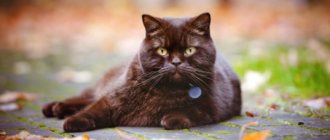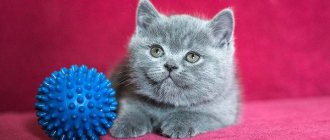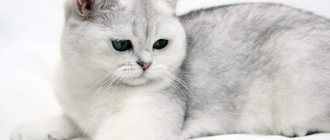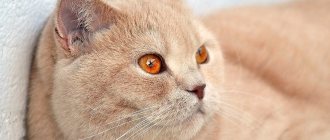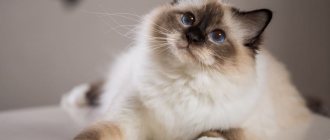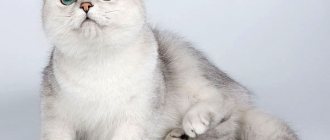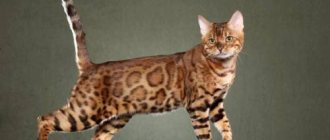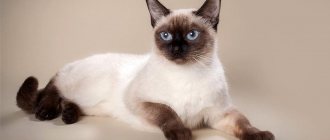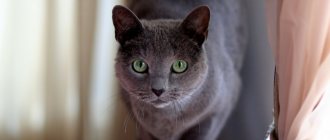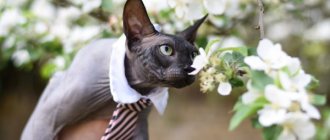When purchasing a kitten, you need to understand that the animal is not a toy: the baby needs care and attention. British shorthair kittens have a plush, dense coat (due to the thick undercoat). Longhaired British kittens also have a thick coat, but the hairs are longer, so they need more grooming and frequent brushing. British kittens: care, education and feeding - how to do it all correctly? Read about this in our article.
British kittens: care, education and feeding
Where is the best place to get a kitten?
It is better to purchase a British kitten from nurseries; it is advisable to find reviews (they must be positive about this breeder). When the kitten turns 3 months old in the nursery, it will be ready to move to a new family, and the breeder will be able to prepare the necessary documents and give the baby vaccinations. This age is also favorable for the baby himself; his immunity will be more or less formed, which means the kitten will get sick less.
Before taking the baby to a new home, you need to examine him so that there is nothing suspicious in appearance and the kitten looks healthy and active. Ask the breeder about the maintenance of the kitten, its nutrition, and read the pedigree of the parents.
Before purchasing a kitten, it is important to study its pedigree and talk to the breeder.
British kittens are distinguished from others by their plush dense coat, round eyes, compact, muscular body with a wide chest. These kittens also have a thick tail and full, short legs. The head should be round, with a wide muzzle, dense nose pads and cheeks.
When purchasing a kitten from a specialized nursery, you can be sure that:
- kitten from purebred parents;
- the veterinary passport reflects all vaccinations performed, including treatment against helminths;
- the kitten will have the metric to participate in exhibition events.
Characteristics of the British cat
more about the standard, characteristics of a British cat , as well as caring for it on our website.
Health
Purebred British dogs are characterized by resistance to common diseases and strong immunity. They are not afraid to sleep on the windowsill with the window open, walk freely in frosty or rainy weather and endure any vagaries of the climate characteristic of England.
But some diseases still appear. Among them is gingivitis. Initially, an inflammatory process is noticed in one tooth, but as it progresses, it affects the remaining teeth. With extended periodontitis, tissue connections separate, resulting in the disease affecting the roots of the teeth.
The next common pathology is hypertrophic cardiomyopathy. It is manifested by the following symptoms:
- Anorexia.
- Lack of appetite.
- Decreased heart rate per minute.
- Breathing problems, wheezing and coughing.
- Sudden loss of limb mobility.
- The appearance of a bluish tint on the paw pads.
To prevent such a disease, it is better to regularly examine the kitten with ultrasound. If he does not show symptoms of the pathology until the age of eight, in the future the risk of its development will be reduced to a minimum.
The British are also susceptible to hemophilia. The problem is characterized by intense bleeding during minor injuries or surgery.
Diseases of British cats include claw fungus. It manifests itself in the form of spots on the claws or their deformation. To protect animals from the problem, it is necessary to constantly monitor the condition of the limbs.
Vaccination is a prerequisite for care. Having important vaccinations reduces the risk of developing panleukopenia, calcivirus, rabies and chlamydia.
The vaccine is administered from 2-3 months of age or at 8 months of age, when the pet has completed the period of changing teeth.
Initially, the cat is given medicine for worms, and if the parasites were not removed and reappeared after 10 days, it is necessary to carry out repeated deworming. And only after 2 weeks is vaccination allowed.
If there are no worms in the stool, vaccination is performed in the basic mode. But after each regular vaccination, a two-week quarantine must be maintained.
When to adopt a kitten?
The ideal age for moving to a new family is 3 months (12 weeks). During this time, the kitten receives the necessary nutrition from the mother, breast milk actively builds immunity, and also allows the baby to develop properly. It is at this age that kittens already weigh about 2 kg. Also at this age, kittens learn from their mother the rules of behavior and caring for their appearance. A responsible breeder provides the necessary vaccinations up to 3 months and carries out preventive work, treating babies against helminths.
The ideal age for a kitten to move to a new family is 3 months.
What should you buy for a British kitten?
Before purchasing a baby, you should take care and buy a few necessary things that play an important role in the life of the future pet.
For a British kitten you need to purchase:
- tray. Pet stores offer a large selection of trays of different sizes and heights. You can start with a small litter box, but as your pet grows, you will need to replace the litter box with a larger one. There are also trays with adjustable side heights (consists of a tray and an additional extension); Their advantage is that while the kitten is small, it can go into a tray with low sides. as soon as it grows up, the height of the sides can be increased by attaching the second part;
- First purchases - a tray and a bowl for a kitten
- scratching post It is necessary so that the baby can wear down his claws and keep the furniture and wallpaper intact. You need to immediately show the kitten why this thing is at home by running the kitten’s paws over the scratching post a couple of times. British cat babies are very smart and quickly learn to use this item;
- toys. To develop dexterity and strength, kittens need a variety of toys; there are a huge number of them in pet stores (balls, teasers, mice, laser toys);
- Buy your kitten a variety of toys so he doesn't get bored.
- tools and supplies for pet care. Scissors for trimming nails, a comb for combing hair, the necessary shampoos for washing - all this can be picked up in specialized stores.
Table 1. Annual kitten care calendar
| Term | Procedure |
| 1 time per year | Preventive vaccinations (rhinotracheitis, calicivirosis, panleukopenia, rabies), urine testing for urolithiasis (urolithiasis) |
| Once every 6 months | Prevention of helminthiasis |
| 2 times a month | Nail trimming, ear and eye cleaning |
| 4 times a month | Preventative examinations of ears and eyes, combing |
| Daily | Preventative examination of external condition |
Video - British Shorthair cat
Colors
The British Shorthair cat today can have about 200 varieties of colors. The traditional coat color of plush cats is ash blue, which is why they are often called the British Blue cat. It is believed that the blue British cat is a true Great Briton. But there are other types of color: black British cat, British cream cat, British chinchilla, lilac, chocolate, and many other different color types and combinations. It is noteworthy that the British cream cat has a delicate pink color of ears and paw pads without the slightest hint of pigmentation. Basic information about color can be found in breed standards, where you can also learn about possible patterns. All varieties of colors have the right to exist.
British kittens weight
This breed is large and massive, so British kittens are heavy. The weight of a newborn British kitten is about 130 g, and within 7 days their weight reaches 150 g. During this period of time, kittens actively feed on their mother's milk. The nutrition of a nursing cat plays an important role in the nutritional value of milk: its diet must be additionally fortified, so the mother of the kittens is fed specialized food or natural food with added vitamins.
Table 2. Kitten weight at different age periods
| Age | Cat weight | Kitty weight |
| Newborn | 70-140 g | 60-140 g |
| 1 Week | 240-260 g | 110-250 g |
| 2 weeks | 340-400 g | 150-360 g |
| 3 weeks | 400-630 g | 210-420 g |
| 4 weeks (month) | 550-740 g | 250-600 g |
| 2 months | 1-1.7 kg | 450-900 g |
| 3 months | 1.5-2.5 kg | 1.5 kg |
| 4 months | 2.1-3.9 kg | 1.7-2.4 kg |
| 5 months | 2.6-4.3 kg | 2.2-2.9 kg |
| 6 months | 3-5.4 kg | 2.3-3.6 kg |
| 7 months | 3.3-5.6 kg | 2.4-3.9 kg |
| 8 months | 3.5-6 kg | 2.5-4.1 kg |
| 9 months | 3.8-6.4 kg | 2.5-4.3 kg |
| 10 months | 4.1-6.7 kg | 2.5-4.4 kg |
| 11 months | 4.3-6.8 kg | 2.5-4.5 kg |
| 12 months (year) | 4.5-7 kg | 2.5-4.6 kg |
British kittens have quite a large body weight
The first days of a kitten in the house
The new resident first needs to adapt: find out where the toilet and food are. In addition, he will look for his mother and call her loudly. New smells and new family members frighten the pet, so it will be natural for the baby to hide in a dark place.
How a kitten gets used to a new home goes like this:
- In the first days, you need to leave the kitten alone and try not to forcefully hold it in your hands if it breaks free and avoids attention. It’s better to start getting acquainted with the kitten, communicating with it in a gentle tone, then the pet can overcome fear and meet you halfway. Also, do not make loud, sharp sounds, which can greatly frighten the new tenant;
- provide the opportunity for the baby to gradually master the territory of the new home. To begin with, let the kitten stay in one closed room for several days, where there will be bowls of water, food and a tray. However, the toilet and food should not be located close together; try to place them far away from each other, but not so that the baby cannot find them. After a few days, when the kitten gets used to it, you can let your pet explore other rooms;
It is necessary to get acquainted with the new tenant gradually, without making loud sounds or making sudden movements
- Usually three-month-old kittens have already been trained by a cat to go to the litter box, but stress and new smells can confuse the baby. Therefore, be patient and be vigilant, as soon as the kitten wants to go to the toilet, immediately move it to a new tray and after all the work, do not wash it for a while so that the kitten can recognize the toilet by the smell. It is best to take a little litter from the tray where the kitten went with its mother, this will make getting used to the new toilet easier;
- Feeding your baby should not change dramatically. Ask the breeder what the kitten ate before moving and at first strictly feed the pet the same diet. The change of food should be smooth: you need to gradually mix the new food with the usual one, otherwise the gastrointestinal tract of a small pet may be disrupted.
In a house where there is a kitten there must be a scratching post
The character of a phlegmatic handsome man
The very name of the breed reveals the character of British cats. They reek of aristocracy, restraint, grandeur and phlegmatism. This is absolutely not the breed whose representatives are able to destroy half an apartment in a matter of minutes. This British Shorthair cat will not tolerate familiarity: no tugging of the tail or ears, no annoying affection. The British are cats who happily accept affection in the form of stroking or scratching, listen with pleasure to the owner’s speech, but at the same time they are offended by harsh, rude words, especially shouting. The character of British cats is such that, if offended, she will not be the first to reconcile. Rather, she will leave and hide somewhere, waiting for the owner to come to her with an apology and something tasty, and she will graciously allow herself to be treated and, perhaps, forgive her offender. A British cat will not be intrusive and bothersome; it will stand and wait patiently until the owner pays attention to it.
The British both cats and cats are amazingly clean and neat creatures. Toilet training is never difficult; toileting is as natural for them as washing in the morning. Living next to these soft and calm creatures is completely comfortable. You must always remember that these reserved individuals are very stubborn. If a cat doesn’t want to do something, it’s simply not possible to force it. You need to take this feature into account and act affectionately, not ordering, but persuading your pet.
An interesting fact is that cats usually like to sit in their owner’s arms, delighting with their endless purring, while female cats show their independence much more, occasionally allowing themselves to be petted. Representatives of the breed all easily coexist with all family members and with other pets, and do not show aggression towards their own or strangers. To summarize, we can say that the characteristics of cats of this breed are entirely positive.
Toilet training a kitten
As soon as the kitten appears in the house, you need to immediately accustom it to the new tray. At first, the baby may be disoriented in a new room and needs help. You also need to consider the location and access to the toilet, because British cats, although clean, have their own opinions. Therefore, if a kitten refuses to go to the new litter box, then you should not think that he is stupid and does not understand anything. In fact, British cats are very smart, and therefore, most likely, the new tenant simply does not like something. Perhaps the tray needs to be moved a little, moved to another corner, or the filler changed.
Instincts tell the kitten that all waste needs to be buried, so choose the appropriate substance for the toilet, because the “British” are clean. If you do not pay attention to this, the kitten may begin to mischief and look for another place to relieve itself.
Training a kitten to use the litter box
If you suddenly find a puddle on the floor, you should not scold the kitten, much less beat it; with this method of education you can provoke the baby to do things secretly in the wrong place. It is better to show your pet in a dissatisfied tone that you are not happy with this situation, and, having collected the puddle with toilet paper, take it to the tray. This way the smell will attract the kitten to go to the right place. It is also worth watching the animal; usually after the baby has eaten, he runs to the toilet. Monitor the kitten's path to the toilet, and then the baby will remember that things need to be done in the litter box.
Don't lose your temper if the kitten doesn't go to the toilet the first time. Remove puddles with special odor-eliminating products that can be purchased at a pet store. Be persistent with your pet and show him where to go, but do not hit him or scream if he suddenly misses. The kitten will sooner or later understand what is required of him, the main thing is to be patient.
In the nursery, cats teach kittens to be clean, so babies come to their new home with toilet knowledge
Origin story
There are several versions and information about the origin of the British cat breed. Scientists are of the opinion that it was bred in the distant past. The official date of appearance of the breed is 43 AD. In those days, Emperor Claudius decided to strengthen his throne by sending 4 legions of his soldiers to the British Isles. But it soon turned out that they did not come there themselves, but with several pets. By chance, the animals quickly adapted to the new climatic conditions and began to breed in Britain.
For 40 years, there were confrontations between the Romans and the Celts, and the animals gradually won the hearts of the English inhabitants with their appearance and behavior.
At the end of the 19th century, residents of the British Isles awarded the breed the title of national.
First moult and grooming
A kitten's first shedding occurs at seven or eight months of age. During the week, the kitten should be carefully combed every day with a special comb, running through the fur with massage movements. After this procedure, you can walk over the fur with your hand in a wet rubber glove, thus collecting the remaining fur. Subsequent molting occurs on an individual basis, depending on many factors - vitamin deficiency, allergic reactions, existing diseases, age-related and hormonal changes, and the use of inappropriate bathing products.
Regular grooming of the British dog's coat with special combs will preserve the beauty of the coat.
You need to groom your pet regularly:
- weekly brushing will bring many benefits to your pet. Firstly, this procedure will rid the cat of dead skin particles and fur hairs, which means that when licking, less of them will end up in the stomach. Secondly, regular brushing gives the animal a healthy and well-groomed appearance;
- if you accustom your kitten to water procedures from an early age, then bathing can become one of your pet’s favorite activities, which can be used both when soiled and for preventive measures;
- Careful trimming of the claws will rid the pet of the rough, keratinized part, which flakes off over time, causing the claws to begin to cling and cause discomfort to the cat. The procedure is short, only a couple of times a month. The haircut is carried out with special scissors, carefully so as not to damage the blood vessel;
- regular preventive examination of the auricle and organs of vision, when the cat’s ears are cleaned of wax accumulation, and the eyes are wiped with black tea infusion or eye drops.
From an early age, a kitten needs to be accustomed to the necessary procedures, then he will calmly endure them and even enjoy them
How to brush British cats?
Before purchasing a British kitten, you should buy special combs at a pet store. To care for your pet you will need:
- a comb with metal teeth with rounded ends so as not to injure the animal’s skin. Needed for primary combing of wool of any length in the direction from head to tail according to hair growth;
- comb with massage effect. Stimulates blood circulation, provides beautiful fur for your pet by combing out dead skin particles and dead hairs. You need to comb your pet with such a comb carefully so as not to damage the delicate undercoat;
- rubber brush or glove. Helps complete your pet's grooming routine. With the help of such a brush you can remove remaining hairs from the surface of the coat after active combing.
A variety of pet grooming products to choose from allows you to keep your cat's coat healthy and beautiful.
Bathing
The first bath of a kitten should be careful and not earlier than one month of age, so as not to scare the baby and not instill a negative impression of the procedure. It is better to teach the kitten to bathe in a playful way, touching the kitten with wet hands, and then gently moistening the baby’s fur with a few drops of warm water. This way, the kitten won’t get scared and won’t start to struggle, and the water, rolling off the fur, will attract attention and interest.
Gradually, with the help of play, the kitten will get used to the water and will allow its body to be completely wet, while you can also gradually begin to use special shampoos that do not have a strong odor. The only exception can be shampoos against parasites, the pungent smell of which can scare away the “British”. Bathing a pet kept in an apartment should not be done more than once every two months, unless treatment or severe contamination of the animal forces it to be done more often.
What do you need to know? The shampoo should be selected based on the length of your pet’s coat and its color, as some products are designed to enhance the color of the animal’s coat.
A kitten's first bath should be no earlier than one month of age.
Bathing stages:
- fill the container with water, adjusting its temperature (about 30 °C);
- pour a special shampoo into the water that suits your pet;
- place the cat in a container with soapy water and gently, massaging the fur, wet the cat’s body;
- rinse off the product with clean warm water, being careful not to get it into your ears, they are very sensitive;
- After bathing, wrap the cat in a dry towel to thoroughly dry the wet fur;
- Place your pet in a warm, draft-free room.
If you gradually accustom your kitten to water procedures, then over time he will enjoy the process and will not be capricious.
Breeding
For decades, breeders have crossed purebred British cats with Scots, but today it is the purity of both varieties that is of particular value. And in some countries the combination of breeds is prohibited by law.
The first estrus begins in cats at five months of age. However, at this time you cannot breed them with cats, because... the body has not yet gone through all the stages of its formation.
Experts recommend choosing a partner for the British breed in a timely manner and agreeing with the owners to meet the male and female cats a couple of days after the heat. It is advisable to leave the cat in the male's house for a while. In this case, the animals will find a connection faster, and the cat will feel more confident in its territory.
If there is no desire to breed offspring, the cat is spayed and the male cat is neutered.
Buying a pet is a responsible decision that requires preliminary preparation. It consists of providing favorable living conditions and purchasing all accessories and things for the cat.
And if a British breed is purchased, its owner must remember to follow the basic rules of cat care. When buying a small animal, you need to take into account all the little things, even the most insignificant ones.
In this case, the growth and development of the pet will occur without problems or deviations.
Upbringing
Before adopting a British breed kitten, it is worth considering that these are wayward animals. Therefore, education should begin from the first days of the kitten’s appearance in its new home. One of the main lessons of education is litter box training. If the kitten does not know that all tasks must be done in a specially designated place, then you need to show him how it is done. If the baby is already trained (usually in nurseries, kittens at the age of 3 months are toilet trained), then you just need to make sure that the pet gets used to the new tray. It is better to immediately show the animal what and how to do, because neglected training will be difficult to correct.
At first, carefully track the kitten’s path to the toilet, so you can teach him to do the necessary things in the right place
During education, force should never be used. British cats are smart, and therefore only a dissatisfied raised tone or clap of the hands can be applied to them, otherwise, when force is used, they can harbor anger or begin to be mischievous. For training, it is better to use repellents with a pungent odor or the smell of citrus fruits, a spray bottle with water, to wean the animal from sharpening its claws on furniture or doing dirty tricks in an inappropriate place.
If the kitten begins to shit, then try to find the reason in the location of the toilet or the composition of the litter
It is also worthwhile to immediately accustom the kitten to the scratching post so that it does not damage the furniture by grinding down its sharp claws. To do this, you need to show the baby several times, running your fingers along the post of the scratching post. You can also use catnip by rubbing dry grass on a post; the smell will attract the kitten’s attention, and he will involuntarily begin to touch the scratching post with his paws.
During games, try to make do with teasers and other toys; do not teach the kitten to play with your hands.
In general, training is not difficult, since the “British” cats are very smart cats, but you should immediately show who is boss in the house by establishing eye contact with the pet, while forbidding him to do nasty things so that he understands the boundaries of what is permitted.
Little “Britons” love to play, so pay more attention to games with your furry fidget
Description of the breed
The British breed cat is a medium-sized animal with an athletic build and short limbs. The pet's head is round in shape, and its muzzle is slightly smoothed. A distinctive feature of their appearance is considered to be fluffy and thick cheeks, as well as slight folds on the skin of the abdomen and neck. Eye color can be amber-yellow, but blue and emerald shades are allowed as standard. Tail length is medium.
Representatives of the breed are characterized by a wayward character and can be touchy. Their cleanliness is emphasized by their high intelligence and grace. The British and Scottish breeds should not be confused. You can distinguish a British cat from a Scottish one not only by its character, but also by its external features.
Feeding a kitten with natural products
List of foods not recommended for cats:
- fatty meats (pork, lamb);
- raw poultry meat and bones (chicken, turkey);
- any raw fish;
- sausages, sausages, smoked cheeses, chocolate, etc.;
- food that a person eats (salty, spicy, sweet).
A diet based on natural products includes the following items:
- lean meat (frozen beef, chicken, turkey, rabbit) - about 8-100 g/day. depending on the age of the kitten;
- offal (liver, heart, kidneys) - 10-100 g/day;
- boiled sea fish without bones no more than once a week gj 6-80 g/day;
- dairy products (cottage cheese - 3.5-20 g/day, kefir, low-fat sour cream no more than 10 g per day, cheese);
- chicken and quail eggs in the amount of 50-55 g per week;
- vegetables (cucumber, carrots, cauliflower, zucchini) - 10-40 g/day;
- cereals (buckwheat, wheat, rice) - 10-80 g/day;
- vitamin and mineral complex (according to instructions).
A balanced diet is the key to the correct and healthy development of the baby.
Table 3. Kitten consumption rate of natural food
| Age | Number of times per day | Daily norm |
| 1-3 months | 5-6 times | 150 gr. |
| 4-6 months | 4-5 times | 240 gr. |
| 7-10 months | 3-4 times | 280 gr. |
| More than 10 months | 2 times | 250-300 gr. |
What do you need to know? Choose wide, flat dishes for your pet to make it easier for him to eat.
Dry food for British kittens
If you decide to choose dry food for your pet, then it is important to consider that “Whiskas”, “Kiticat”, “Purina”, “Friskies”, “Felix” and similar low-quality foods are not suitable for a complete healthy diet. They contain a huge amount of flavors, dyes, taste enhancers and other harmful chemicals, which cause many diseases associated with urolithiasis and gastrointestinal tract disorders. It is better to use high-quality industrial feed, which is completely ready for consumption.
Each manufacturer has its own calculation table for feeding a kitten by month, so you just need to follow the recommendations and make sure that the kitten always has access to fresh water. The main thing is to choose high-quality food for your kitten from a good holistic, superpremium or premium manufacturer. Then you can be sure that the baby will grow up healthy and strong.
Brit food for kittens
Dry and wet food that can be fed to a British kitten:
- Among the good holistic foods for kittens you can buy: Eukanuba, Brit, PronatureHolistic, Primordial. The advantage of this class of food is that it is hypoallergenic. The diets have an optimal ratio of proteins, fats and carbohydrates, and also contain dietary supplements;
- super premium food: Hill's Science Plan, Orijen, Now Fresh, 1st Choice, Schesir;
- premium food: Pro Plan, Happy Cat, Leonardo, Brit Premium, Royal Canin.
What do you need to know? If the kitten ate industrial food in the nursery, then you should not immediately start feeding it natural food or other dry food, as this can disrupt the functioning of the gastrointestinal tract and lead to complications. Therefore, find out what brand of dry food the kitten was eating, and feed it this particular food for the first time. The transition should be smooth: gradually mix in other food to avoid health problems for the baby.
Choose high-quality food from a well-known manufacturer for your pet
